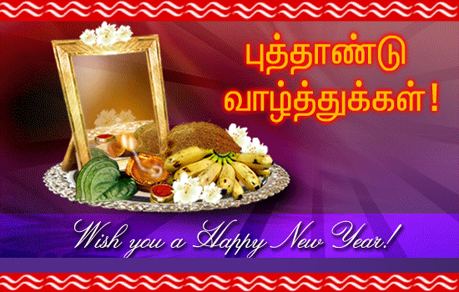2017 Date 14 April 2017 | ||
 | ||
Celebrations Feasting, gift-giving, visiting homes and temples Related to Observances Feasting, gift-giving, visiting homes Similar Onam, Ugadi, Vishu | ||
2016 04 13 tamil new year celebrations
Puthandu (Tamil புத்தாண்டு), better known as Tamil New Year, is the first day of year on the Tamil calendar and is celebrated by ethnic Tamils in Tamil Nadu and Puducherry in India, Sri Lankan Tamils and Indian Tamils of Sri Lanka, and by Tamils in Malaysia, Singapore, Réunion, Mauritius and Tamil diaspora. On this day, Tamil people greet each other by saying "Puttāṇṭu vāḻttukkaḷ!" ( புத்தாண்டு வாழ்த்துக்கள்) or "Iṉiya tamiḻ puttāṇṭu nalvāḻttukkaḷ!" (இனிய தமிழ் புத்தாண்டு நல்வாழ்த்துக்கள்). The festive occasion is in keeping with the Hindu solar Calendar.
Contents
- 2016 04 13 tamil new year celebrations
- Puththandu malar 2016 tamil new year celebration singapore telok blangah cc
- Origin and significance
- Celebration
- Controversy
- Tiruvalluvar Era
- Related holidays in other cultures
- References

Puththandu malar 2016 tamil new year celebration singapore telok blangah cc
Origin and significance

The Tamil New Year follows the vernal equinox and generally falls on 14 April of the Gregorian year. 14 April marks the first day of the traditional Tamil calendar and is a public holiday in both Tamil Nadu and Sri Lanka. The Tropical vernal equinox falls around 22 March, and adding 23 degrees of trepidation. The Tamil calendar thus begins on the same date observed by most traditional calendars in India as in Assam, West Bengal, Kerala, Manipur, Mithila, Odisha, Punjab and Tripura, and in Nepal, Bangladesh, Burma, Cambodia, Laos, Sri Lanka and Thailand. The 60-year cycle is ancient and is observed by most traditional calendars of India and China, and is related to 5 revolutions of Jupiter, or to 60-year orbit of stars.

The 60-year cycle comes by 5 revolutions of Jupiter and 2 revolutions of Saturn. The relative position of Jupiter and Saturn in one particular year will be repeated after 60 years. The 60-year cycle was essentially conceived for predicting the climate of a particular year, as the relative position of the two major planets, Jupiter and Saturn, is recognized for its impact on climate.

There are several references in early Tamil literature to the April new year. Nakkirar, Sangam period author of the Neṭunalvāṭai, wrote in the third century that the sun travels from Mesha/Chitterai through 11 successive signs of the zodiac. Kūdalūr Kizhaar in the 3rd century refers to Mesha Raasi/Chitterai as the commencement of the year in the Puṟanāṉūṟu. The Tolkaapiyam is the oldest surviving Tamil grammar that divides the year into six seasons where Chitterai marks the start of the Ilavenil season or summer. The 8th century Silappadikaaram mentions the 12 Raasis or zodiac signs starting with Mesha/Chitterai. The Manimekalai alludes to the Hindu solar calendar as we know it today. Adiyarkunalaar, an early medieval commentator or Urai-asiriyar mentions the twelve months of the Tamil calendar with particular reference to Chitterai. There were subsequent inscriptional references in Pagan, Burma dated to the 11th century CE and in Sukhothai, Thailand dated to the 14th century CE to South Indian, often Vaishnavite, courtiers who were tasked with defining the traditional calendar that began in mid-April.
Celebration

Tamil people celebrate Tamil new year on 14 April. This is the month of Chitterai, the first month of the Tamil solar calendar. On the eve of Puthandu, a tray arranged with three fruits (mango,banana and jack fruit), betel leaves and arecanut, gold/silver jewellery, coins/money, flowers and a mirror is placed. This is to be viewed upon waking in the morning. In the Temple city of Madurai, the Chitterai Thiruvizha is celebrated in the Meenakshi Temple. A huge exhibition is held, called Chitterai Porutkaatchi. In some parts of Southern Tamil Nadu, it is called Chittirai Vishu. The day is marked with a feast in Tamil homes and entrances to the houses are decorated elaborately with kolams. In most parts of India, one can see neem trees blooming with their flowers and the first batch of mangoes hanging prominently. This day is celebrated by some communities with neem flowers and raw mangoes to symbolize growth and prosperity.

On the day of Tamil New Year, a big Car Festival is held at Tiruvidaimarudur near Kumbakonam. Festivals are also held at Tiruchirapalli, Kanchipuram and many other places.
Sri Lankan Tamils observe the traditional new year in April with the first financial transaction known as the 'Kai-vishesham' where elders gift money to the unmarried young, particularly children as a token of good luck. The event is also observed with the 'arpudu' or the first ploughing of the ground to prepare for the new agricultural cycle. The 'punya-kaalam' or auspicious time when the sun reportedly shifts from Meena raasi to Mesha raasi is considered ideal to commence new activities on a favorable note. Sri Lankan Tamils begin the year with a herbal bath with 'maruthu-neer' with ingredients for good health. The game of 'por-thenkai' or coconut wars between youth is played in villages through the Tamil north and east of the island while cart races are also held. The festive Puthandu season in April is a time for family visits and the renewal of filial bonds. It coincides with the Sinhalese new year season.
In Malaysia and Singapore, Tamils join Sikhs, Malayalees and Bengalis to celebrate the traditional new year in mid-April with leaders across the political spectrum wishing the ethnic Indian community for the new year. Special religious events are held in Hindu temples, in Tamil community centers and Gurudwaras. Cultural programs and media events also take place. Its a day of celebration for the Indian community.
Controversy
The previous Dravida Munnetra Kazhagam (DMK)-led Government of Tamil Nadu had declared in 2008 that the Tamil new year should be celebrated on the first day of Tamil month of Thai (14 January) coinciding with the harvest festival of Pongal. The Tamil Nadu New Year (Declaration Bill 2008) was introduced in the House by the Tamil Nadu Government on 29 January 2008. This bill of the DMK Administration was subsequently rescinded by a separate act of legislation in the Tamil Nadu Assembly on 23 August 2011.
The earlier legislative enactment of the DMK government was not without controversy . The resolution was met with resistance. It was challenged in court. The then opposition All India Anna Dravida Munnetra Kazhagam (AIADMK) and Marumalarchi Dravida Munnetra Kazhagam (MDMK) in Tamil Nadu subsequently condemned the decision of the DMK Government in that state and urged their supporters to continue celebrating the traditional date in mid-April. Tamils in Sri Lanka, Singapore, Malaysia and Canada continued to observe the new year in mid-April. Many in Tamil Nadu continued the celebration of the new year in mid-April. The Governor and Chief Minister of the Indian Union Territory of Puducherry, which has an ethnic Tamil majority, felicitated the public for the Tamil new year in April 2010. The previous state government in Tamil Nadu in an effort to accommodate popular sentiment conceded the celebration of the April new year with a new term called “Chithirai Tirunal” (the festival of Chithirai). The day remained a public holiday in Tamil Nadu albeit purportedly to commemorate Dr. B.R Ambedkar, who was the Chairman of the Drafting Committee of Indian Constitution. All television channels in Tamil Nadu continued to telecast festive “Chithirai Tirunal Special Programs” on 14 April 2010. The leader of the AIADMK, Jayalalitha felicitated the people on the traditional Tamil New Year. The MDMK leader Vaiko, followed suit. Press reports indicated that the people in Tamil Nadu celebrated the Tamil New Year with enthusiasm and thronged the temples in thousands. There are others who highlight the absence of historical and literary evidence for the change in new year. The 2008 legislation of the previous DMK-led administration has since been annulled by an act of the Tamil Nadu Assembly in August, 2011. The controversy has now subsided and the official celebrations during the traditional new year in April revived.
Tiruvalluvar Era
The 2006–2011 Government in Tamil Nadu also introduced the Tiruvalluvar era that begins with the purported birth of the Tamil literary figure Tiruvalluvar in the year 31 BCE. The literary evidence however may not indicate an early date for Tiruvalluvar. The syntax and grammar may indicate a subsequent date. Renowned Tamil Scholar Vaiyapuri Pillai was of the view that Tiruvalluvar lived around 600 CE, based on the internal evidence of his work and the significant influence of Sanskrit, Prakrit and Pali works in the Tirukkural. While not all may agree with Vaiyapuri Pillai's textual Criticism and dating, several question the Tiruvalluvar era on the issue of its date. However, the Government of J. Jayalalitha in 2011 reverted the celebration of Puthandu to the original date of fourteenth of April.
Related holidays in other cultures
The Pallavas and Cholas under Rajendra Chola's reign 1012 CE – 1044 CE culturally influenced certain regions in South and Southeast Asia.
- Sinhalese New Year officially known as Sinhala and Tamil New Year, Sri Lanka
- Thai New Year or Songkran in Thailand is celebrated on the same day as well.
- Bengali New Year or Pohela Boishakh (India's West Bengal and Tripura state and Bangladesh)
- Assamese New Year or Rongali Bihu (India's Assam state)
- Malayali New Year, or Vishu (India's Kerala state)
- Nepali New Year, or Bikram Samwat / Vaishak Ek (Nepal)
- Vishuva Sankranti-Odia New Year (India's Odisha state)
- Maithili New Year in Mithilanchal (eastern region of Bihar and Jharkhand).
- Khmer New Year, or Chol Chnam Thmey (Cambodia)
- Lao New Year, or Songkan / Pi Mai Lao (Laos)
- Tuluva New Year, or Bisu (India's Karnataka state)
- Burmese New Year, or Thingyan (Burma)
